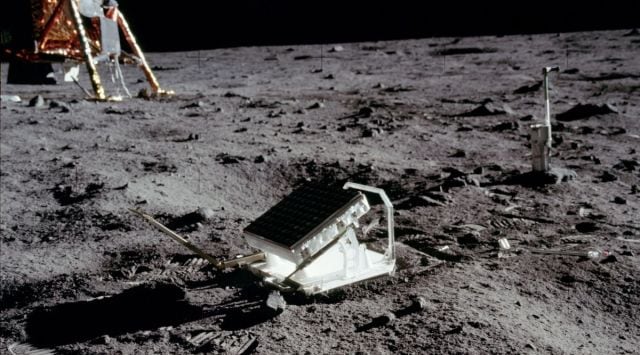Apollo 11: This tool placed on the Moon by Neil Armstrong, Buzz Aldrin still works
When the Apollo 11 mission landed on the Moon, Neil Armstrong and Buzz Aldrin placed a tool on the Moon that is still in use today.
 This retroreflector was left on the Moon by Apollo 11 astronauts. (NASA)
This retroreflector was left on the Moon by Apollo 11 astronauts. (NASA) Exactly 54 years ago, on July 20, 1969, Apollo 11 astronaut Neil Armstrong stepped onto the lunar surface—the first human to ever walk on the Moon. Shortly after, his colleague Buzz Aldrin joined him. When they landed on the Moon all those years ago, the two astronauts placed a tool on the Moon that is still working today.
The “tool” in question is the laser ranging retroreflector (LRRR). It is a “retroreflector array” built on a folding support structure for aiming and aligning the array towards Earth. It was built of cubes of fused silica. Laser-ranging beams sent from Earth to the Moon are reflected back by LRR, which will help scientists here make precise measurements of the distance between the bodies.
The distance between the two bodies is calculated by measuring the time required for the brief pulse of light to return to our planet. This measure can be so accurate that the maximum variance from the true figure will be around six inches, according to an article in the journal Science.
“The important quantity, however, is not the absolute distance between the Earth and the Moon at some particular instant but the variations in distance measured with six-inch precision or better over a period of months and years. Such variations can be studied to answer a number of important questions,” wrote James Faller and Joseph Wampler in the March 1970 issue of Scientific American. Faller is the one who conceived the idea behind LRRR.
Since LRRR was placed on the Moon, four other retroreflectors were also placed on Earth’s only natural satellite—three were placed by the United States’ Apollo missions while two were placed by the Soviet Union’s Luna missions.
Lunokhod 1, the first retroreflector placed by the Soviet Union on the Moon on November 17, 1970, was “lost” for nearly forty years, according to Space.com. It wasn’t heard from since September 14, 1971, but it was “rediscovered” by astrophysicists in 2010. That, and all the other retroreflectors, are still operational.
A couple of missions that aimed to put retroreflectors on the Moon ended up in failure like the Israeli-led Beresheet mission and notably, India’s Chandrayaan-2 mission. Both Beresheet and Chandrayaan crashed on the lunar surface in 2019.







